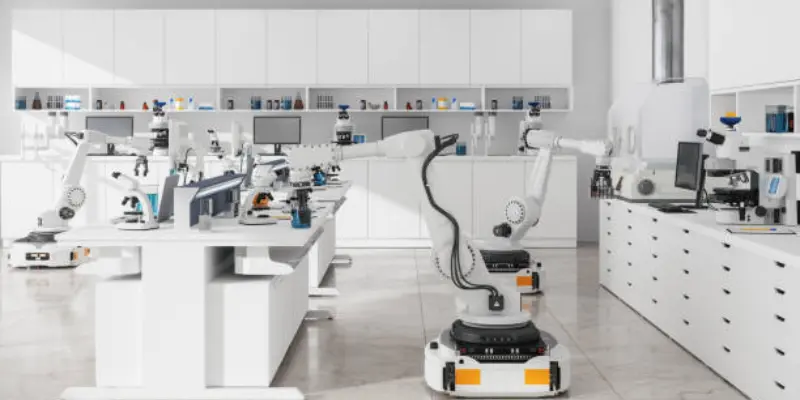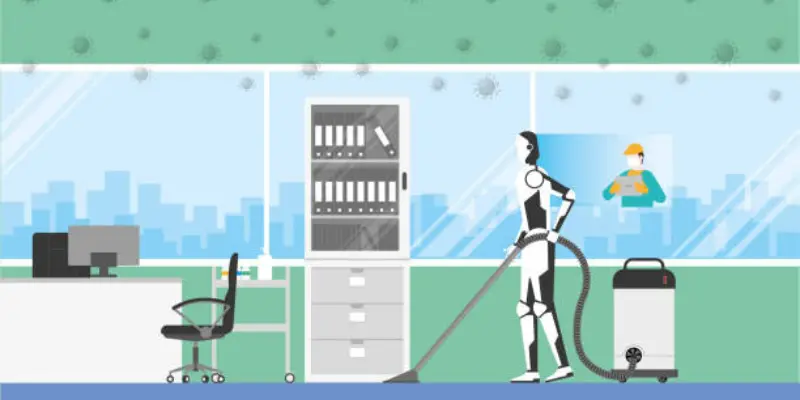What are the Benefits of AI Robots in Hospitals
Published: 24 Apr 2025
AI robots in healthcare are transforming the way hospitals care for patients. In 2024 alone, over 50% of top medical centers worldwide adopted robotic systems to assist in surgery, monitor patients or deliver medication. These AI-powered machines are not only reducing human errors but also speeding up routine tasks by giving doctors more time to focus on patient care. With the rise of AI robots in healthcare, hospitals are now becoming smarter, faster and more efficient than ever before.
In this article, I am going to explore the benefits of AI Robots in Hospitals. Let’s discuss the benefits in great detail.

A). They Make Hospital Work Faster
AI robots help hospitals run smoothly. They do many small jobs that take up staff time. This means nurses and doctors can focus more on patient care.
a). They Deliver Supplies
Robots carry medicines, files and food to different rooms. They don’t get tired or distracted.
Example:
A robot called TUG moves around the hospital. It brings medicine to nurses or takes samples to the lab.
b). They Help With Cleaning
Some robots clean floors and rooms. Others use special light to kill germs. This helps keep the hospital safe and neat all day.
Example:
UV-cleaning robots are used in many hospitals after a patient leaves the room. They clean fast and help stop the spread of infection.
c). They Work All Day and Night
AI robots don’t need to take breaks. They can work 24/7. This is helpful in emergencies or during night shifts when fewer people are working.
Example:
A patient admitted in the hospital needs care all day and night. He can talk to AI-assisted robots that hospitals are utilizing.
💡 Why This Matters
Fast, clean and smooth hospital work means better care. When robots do routine tasks, hospital staff can do what they do best, take care of people.
B). They Reduce Human Errors
Mistakes in hospitals can be serious. Giving the wrong medicine or missing patient details can harm someone. AI robots help to reduce these tiny errors.

a). They Remember Things Perfectly
AI robots don’t forget like us. They follow instructions exactly and remind staff about important steps.
Example:
A robot can remind nurses to give medicine on time. It can even alert them if the dose is too high or too low.
b). They Check Patient Info
Before giving medicine or doing a task, AI robots can scan patient details. This makes sure the right care goes to the right person.
Real-life Example:
Some robots scan barcodes on wristbands to match the patient with the right treatment. This double check keeps everyone safer.
c). They Handle Repetitive Tasks Well
Robots do the same task again and again—without getting tired or distracted. That’s important when accuracy matters.
Tip for Hospitals:
Use AI robots for jobs like checking temperatures, updating records or delivering labeled medicine packs.
💡 Why This Matters
When robots help with checking and tracking, fewer mistakes happen. That keeps patients safe and helps the hospitals to run better.
C). They Support Patient Care
AI robots help in taking care of patients in many ways. They can assist doctors and nurses, and even talk to patients to keep them company if needed.
a). Talking to Patients
Some robots can chat with patients. They answer simple questions or remind patients to take their medicine.
Example:
Pepper is an AI robot used in hospitals to talk with patients. It asks how they are feeling and helps them stay calm.
b). Helping Patients with Medicine
Robots can remind patients to take their medicine on time. Some robots even help by bringing the medicine directly to them.
Real-life Impact:
This can be especially helpful for patients with memory problems, like the elderly. Robots make sure they don’t forget to take important medication.
c). Supporting Nurses and Doctors
Robots can help with some of the more repetitive tasks, like taking vital signs or bringing test results. This lets nurses and doctors spend more time with patients.
Example:
Robotic nurses can measure blood pressure and give doctors quick updates on patient conditions.
💡 Why This Matters
When robots help with patient care, it improves the overall experience. Patients feel more comfortable and doctors can focus on complex medical tasks.
D). They Keep Hospitals Cleaner
Hospitals need to stay very clean to stop the spread of germs. AI robots help with cleaning tasks, making sure the hospital remains safe for everyone.

a). Cleaning Floors and Rooms
Some robots clean floors all day long. They move around the hospital, sweeping and mopping without getting tired or feeling frustrated.
Example:
Floor-cleaning robots move around, cleaning hallways and rooms without needing anyone to push them.
b). Using UV Light to Kill Germs
Other robots use UV light to clean rooms. The UV light kills bacteria and viruses, helping to keep the hospital clean.
Real-life Example:
Xenex LightStrike is a robot that uses UV light to disinfect rooms after a patient leaves. It helps in preventing the spread of infections.
💡 Why This Matters
A clean hospital means fewer infections. Robots make it easier for hospitals to stay clean all the time.
E). Other Benefits
AI robots bring even more advantages to hospitals. Here are a few other reasons why they are so helpful.
They Help With Surgeries
Some robots assist doctors during surgery. They make small, precise movements that help with delicate procedures, making surgeries safer.
AIrobots use special tools that allow doctors to perform surgery more accurately. These robots can make tiny movements that are difficult for humans to do in non-accessible body parts.
Example:
The da Vinci Surgical System is used in many hospitals for surgeries like prostate or heart surgery. It helps doctors to make smaller cuts and operate more precisely.
They Work 24/7 Without Breaks
AI robots don’t need rest. They can work around the clock day or night without getting tired.
This is especially helpful in busy hospitals, where the work never stops. Robots can assist during night shifts or in emergency situations.
Example:
Robotic assistants help during the night, delivering medicine or checking on patients without the need for human breaks.
They Support Rehab and Therapy
In rehabilitation patients need someone to assist in daily routines. Some AI robots help patients during physical therapy. They can guide movements and track progress, helping patients recover faster.
Example:
Rehabilitation robots assist patients with movement exercises after surgery, offering support and tracking improvements.
They Improve Data Management
AI robots can manage patient data. They store records, organize test results and ensure everything is up to date and easy to find.
Example:
Data robots automatically update patient files after tests which saves time and reduces the risk of errors.
How Hospitals Can Start Using AI Robots
Hospitals can begin using AI robots in a few simple steps. It doesn’t happen overnight but it’s worth the effort. Here’s how they can get started.
Step 1: Start Small
Hospitals don’t need to use robots for everything right away. It’s a good idea to start with just one or two robots for specific tasks like cleaning or delivering supplies.
Hospitals can take a start by using floor-cleaning robots to keep the hospital clean. Once they see the benefits, they can add more robots for other tasks.
Step 2: Budget and Plan
AI robots can be expensive at first but they save money over time. Hospitals need to plan and budget for these investments. They can look for grants or funding to cover up the cost.
Step 3: Train Staff
Hospital staff need to know how to work with robots. Hospitals should train staff on how to use the robots safely and effectively.
Most AI robots come with training guides or support teams to help hospital staff learn how to use them.
Step 4: Evaluate and Improve
After using AI robots for a while, hospitals should check how well they are working. They can look at how much time they save and if the robots are improving patient care. Based on this feedback, hospitals can make improvements.
Also Read: AI as Caregiver in Healthcare
Challenges to Know
While AI robots offer many benefits, there are also some challenges that hospitals need to consider before implementing AI robots. It’s important to be aware of these as hospitals start using robots.

High Initial Costs
One of the biggest challenges is the high upfront cost of buying AI robots. They can be expensive to purchase and maintain. Setting up hardware and software can be out of reach for smaller hospitals.
Tip:
Hospitals can plan for these costs by starting with just a few robots and expanding over time.
Training Staff
Hospitals need to train their staff to use the robots safely and effectively. This training can take time and may require extra resources.
Example:
Hospitals may need to hold special training sessions for doctors and nurses to help them get comfortable working with AI robots.
Robot Limitations
AI robots can do many things, but they still have limits. They can’t make decisions on their own and need human supervision. It’s important to remember that robots work alongside healthcare professionals, not replace them.
Privacy and Security
AI robots collect data about patients, which raises concerns about privacy and security. Hospitals need to make sure they protect patient information and follow the law.
Example:
Hospitals must follow strict rules to keep patient data safe and ensure that robots can’t be hacked.
Conclusion
AI robots are changing the way hospitals work. They help with surgeries, improve patient care, keep hospitals clean and much more. While there are some challenges, the benefits are clear. AI robots make hospitals safer, more efficient and accessible.
Key Takeaways
- AI robots assist doctors and nurses, making their jobs easier and more precise.
- They help in improving patient safety and hospital cleanliness.
- With proper planning, hospitals can use AI robots to save time and money in the long run.
As AI technology makes our life easier, AI robots will become even smarter. They will continue to support healthcare workers and improve patient care. The future of hospitals with AI robots is exciting and we are only just getting started.
Potential FAQs for “Benefits of AI Robots in Hospitals”
Here are frequently asked questions about benefits of AI Robots in Hospitals;
Hospital AI robots range widely in price from $30,000 for basic delivery robots to over $2 million for advanced surgical systems like da Vinci. Many hospitals start with leasing programs or smaller robots to manage initial costs. The long-term savings in staff time and reduced errors often justify the investment over several years.
AI robots are not designed to replace healthcare professionals but rather to support them by handling routine or repetitive tasks. They free up medical staff to focus on the human aspects of care that require empathy, critical thinking and complex decision making. Studies show hospitals maintain or even increase staffing levels after introducing robots but shift staff to more meaningful patient interactions.
Patient reactions vary widely, with many expressing curiosity and acceptance, particularly after seeing the benefits firsthand. Some elderly patients initially show hesitation but often become comfortable with robots that have regular interactions, like medication reminder robots. Children typically show the most positive responses, often viewing care robots as interesting technology rather than intimidating medical equipment.
Hospital robots undergo rigorous safety testing with multiple built-in sensors to detect obstacles and prevent collisions. They operate at carefully controlled speeds and can immediately stop if they encounter unexpected resistance. Many robots used directly with patients have rounded edges, soft exteriors and emergency stop buttons accessible to both patients and staff.
Basic training for most hospital robots typically takes 1-2 weeks for staff to learn operational procedures. More complex systems like surgical robots require specialized training that can take several weeks or months for surgeons to master. Most robot manufacturers provide ongoing support, updates and refresher training as part of their service agreements.
Hospitals maintain backup procedures where staff can quickly resume manual processes if a robot malfunctions. Most hospital robots have remote monitoring capabilities allowing technical teams to diagnose and often fix software issues without disrupting service. Critical robots typically have service agreements ensuring rapid response times from manufacturer technicians for hardware problems.
Hospital robots operate under the same privacy regulations (like HIPAA in the US and GDPR in UK) that govern all healthcare operations. Data collected by robots is encrypted and integrated into secure hospital information systems rather than stored on the robots themselves. Access to robot-collected information requires the same authorization levels as other patient data in the hospital system.
Smaller hospitals often begin with targeted robot implementations in high-impact areas like pharmacy or laboratory services. Government grants, healthcare innovation funds and shared-service models with nearby facilities can make robotic technology more accessible for smaller institutions. Robot manufacturers increasingly offer scalable options and financing programs specifically designed for smaller healthcare facilities.
Most hospital robots are surprisingly energy-efficient, using approximately the same electricity as a small household appliance when active. Robots typically have self-docking features to recharge during low-demand periods which minimizes energy usage. The environmental impact is often offset by reduced waste and more efficient resource use throughout the hospital.
Current hospital robots execute predefined tasks and are not allowed to make independent medical decisions. AI is developing to provide decision support by analyzing patterns and suggesting options but final medical decisions remain with qualified healthcare professionals. The future points toward collaborative models where AI helps to identify concerns or opportunities that human medical staff then evaluate and act upon.





